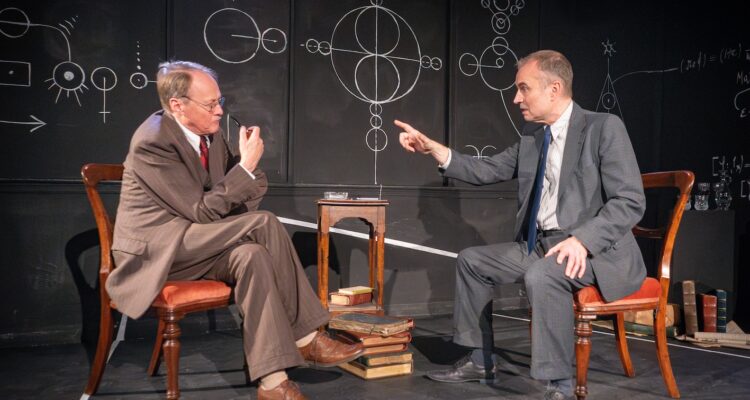It’s a bold step to produce a play about science. Synchronicity is about the great nuclear physicist Wolfgang Pauli and the psychoanalyst Carl Jung.
Pauli was one of the fathers of quantum physics, having made decisive contributions to the structure of matter. When we first see him he is howling like an animal, pacing and drinking from an ever-present hip flask. When he first meets Carl Jung the psychoanalyst says it was as if ‘the wind had blown over from the lunatic asylum.’
Pauli is played with profound expressions of ferocity and pain by Jeremy Drakes who rocks in his chair and snarls his answers, recognising with his superior intelligence that he needs help but resisting it at every stage. Pauli’s drinking, bar-room fights and whoring are taking over his life which is otherwise one of superlative brilliance. He really is in need of psychological help.
Jung, the great psychoanalyst and former disciple of Freud, is avuncular and omniscient sucking on his pipe in his consulting room. He is played with ease and unruffled superiority by Stephen Riddle. He has his own obsessions and addictions which are exposed in his asides to the audience.
Their sessions progress via Jungian tropes: the animus, the four archetypes and the collective unconscious. The realm of interplay between the different worlds of the characters is alchemy, the physical science of pre-Renaissance times. This is represented on the set which has the equations of nuclear physics on one side and alchemical symbols on the other. In the course of the action, Pauli learns a lot more about alchemy than Jung does about theoretical physics. The men come together on sychronicity, supposedly the area where the psychic and the physical manifest in unusual occurrences in the real world.
In the second half of the play, with Jung telling Pauli’s dreams and analysing them, dramatic interest droops. The stakes are too low. It doesn’t help that the Pauli’s treatment in real life came from his work with another therapist, a student of Jung’s called Erna Rosenbaum who is acknowledged but off-scene in the play. Effectively, the tension of wondering whether or how Pauli will recover is lost. Pauli gets better, all smiles and hugs. He marries and settles down, wins the Nobel prize, he is cured.
Did the encounter with Pauli bring reciprocal benefits to Jung? Does Jung come to terms with his sex with students and patients, anti-Semitism, wartime accommodation with the Nazis? No, not really, it wasn’t really troubling him much in the first place. For him that’s just the way things are. Well, I suppose it wasn’t Jung who was going to a therapist.
There is some clear, sharp dialogue here and a play featuring these big concepts which did so much to shape the following century deserves a welcome. Anyone looking for a mentally stimulating evening would do well to visit Arthur I. Miller’s play.
Theatre: White Bear https://www.whitebeartheatre.co.uk/
Playwright: Arthur I. Miller
Cast: Stephen Riddle, Jeremy Drakes
Production pics: Dawson James
Duration: 1 hour 40 minutes plus interval
Until: November 30 2024

